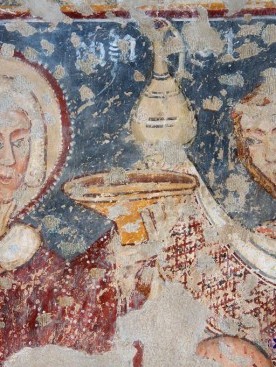The Roman Catholic Church – BaktalórántházaDuring the Middle Ages, the village was owned by the Baktai family and was mentioned for the first time in a diploma in 1317. The register on the Papal Tenth (drafted between 1332 and 1334) mentions neither the village, nor the church. This means that the church could have not been built before 1334. The probable time of completion was around 1340 and the person who ordered the construction of the church must have been a member of the Baktai family. During the very first building period, a church composed of a nave with a flat ceiling and a sanctuary connected to its eastern end was erected. These structures were connected to one another by a semi-circular lancet arch, while the sanctuary had a square base and was covered by a barrel vault. Diagonal buttresses fortified the nave and the corners of the sanctuary. Two lancet windows cut across the eastern wall of the sanctuary. In the middle of the nave’s western wall, there is a gate encased in a Renaissance-style stone frame. A tabernacle spanned by a lancet arch was carved into the northern wall of the sanctuary. The walls of the church are built of bricks of different colours. Most of them are red, but there are also bricks with black or green coating. During the exploration of the church, carried out in 2009, remains of the medieval greyish plaster have been discovered, too. Protestants started using the church in the second half of the 16th century, but the place of worship was returned to the Catholics in 1731. This is the period when the church was extended in westward direction and the tower was erected. The Renaissance-style portal taken out from the demolished medieval western wall of the nave was inserted in the eastern wall of the tower. The church was later refurbished in 1856, when the buttresses were torn down and new windows were cut. The restoration work inside the Roman Catholic church of Baktalórántháza commenced in 1962, when the mural painting of the Crucifixion was found on the eastern wall of the sanctuary. In later periods, this was covered by the altar-piece, and could not be seen until recently. Neither were the hidden treasures of the sanctuary known. The exploration of the murals was completed during the summer of 2010, but this procedure revealed a series of sensational paintings being hidden under the layers of plaster all around the surface of the sanctuary’s walls. Next to the sanctuary, the walls of the nave also hid beautiful paintings, which were also revealed one by one. Their restoration took place in 2012 and, consequently, an amazing set of frescoes can now be seen. The conception inspiring the restoration work was to reveal all original details, and if some details had to be added, this operation should not disturb at all the admiration of the Gothic paintings. As a result, the most important and most successful restoration in 2012 was performed on Hungarian soil in Bakta. The middle register on the eastern wall of the sanctuary depicts the crucified Christ with Mary and Saint John the Evangelist under the cross. On the same wall, in the lower register, we can see a scene form the legend of Saint Elizabeth of Hungary. The vault of the sanctuary is decorated with two paintings: on one side Christ surrounded by a mandorla, on the other The Holy Mary with the baby Jesus. The mural on the nave’s northern wall depicts the crowning of king Saint Ladislaus, while the one on the southern wall shows Saint Helena with the cross. On the northern side of the chancel arch, details of a painting telling Saint Dorothy’s legend have been preserved. The murals must have been created at the beginning of the 15th century. |
















